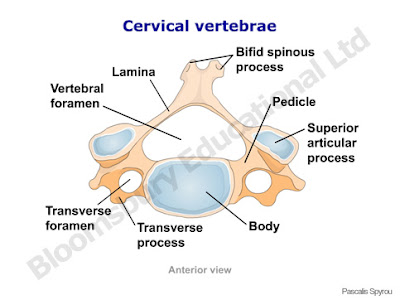SPM 2005 P1
The human skeleton
SPM 2007 P2
Vertebral column
- 33 vertebrae - 7 cervical
- 12 thoracic
- 5 lumbar
- 5 sacral (sacrum)
- 4 caudal (coccyx)
Explain one feature of vertebra thoracic which is related to the mechanism of respiration
- Has two articulating surfaces on the transverse process, forming points of articulation for the rib
- It has a long neural spine for better muscle attachment
Explain the role of the vertebrae when movement of the body occurs
- The vertebral column consists of several vertebrae which are joined together by intervertebral discs
- It also provides surfaces for the attachment of the skeletal muscles
Osteoporosis - bones become thinner, more brittle and more porous / porous and has more spaces
An individual suffering from osteoporosis is advised to drink plenty of milk . Explain why.
- Milk contains calcium which is necessary for bone growth
SPM 2008 P1
SPM 2005 P2
Explain how the above movement takes place which involves muscles, tendons, ligaments and joints
- tendons join muscles to bones. tendons are inelastic
- force is transferred to the bones through the tendons
- ligaments join two bones at a joint. they give support to the joint during movement. they are strong and
elastic
- as an example, a hinge joint allows the leg to bend
- the quadriceps / extensor muscle contracts whereas the biceps femoris muscle relaxes and the leg is
straightened
- the biceps femoris muscle contracts whereas the quadriceps femoris muscle relaxes and the leg is bent
- the calf muscle contracts to pull the heel
- the heel is pushed downwards and backwards, the repeated action of contraction and relaxation produces
the running action
- the long and thick bone at the centre gives strength to support the body weight
Explain how the skeletal system of earthworm and fish are adapted for its movement
Earthworm
- the earthworm has a hydrostatic skeleton. It moves by changing the hydrostatic pressure of its body fluid
- the circular muscles contract and the longitudinal muscles relax antagonistically. This causes the transfer of
hydrostatic pressure from the anterior to the posterior which causes the body to move to the front
Fish
- fish has an endoskeleton
- the endoskeleton is a place for muscle attachment. The left myotome muscles contract and the right
myotome muscles relax antagonistically and the tail moves to the left and right producing a forward force







没有评论:
发表评论